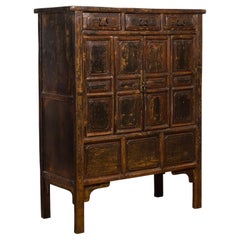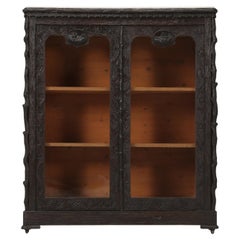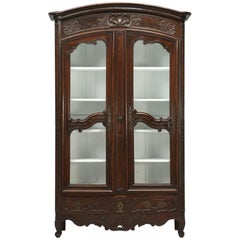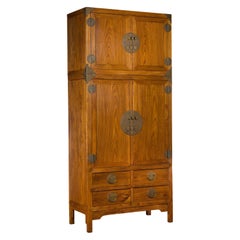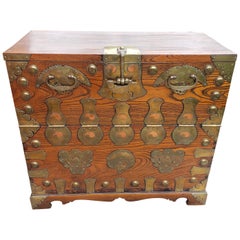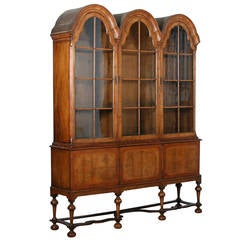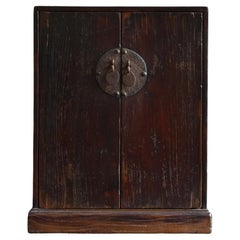1800s China Cabinet
Antique Early 19th Century Chinese Qing Cabinets
Wood
Antique 1880s Swiss Black Forest Bookcases
Marble
Antique Early 1800s French Louis XV Wardrobes and Armoires
Steel
Antique Early 19th Century Chinese Qing Cabinets
Brass
Antique Mid-19th Century Chinese Tang Commodes and Chests of Drawers
Brass
Recent Sales
Antique 19th Century American Cabinets
Glass, Wood
Antique 19th Century Chinese Qing Cabinets
Pine
Antique Mid-19th Century Chinese Sideboards
Antique Late 19th Century French Bookcases
Walnut
Antique 19th Century Chinese Qing Wardrobes and Armoires
Rattan, Wood
Antique 19th Century Chinese Wardrobes and Armoires
Bronze
Antique 19th Century Chinese Furniture
Brass
Antique 1820s English Chinese Chippendale Secretaires
Mahogany
Antique Late 19th Century Chinese Furniture
Iron
Antique 19th Century Chinese Furniture
Brass
Antique 19th Century Chinese Cabinets
Brass
Antique Early 19th Century Chinese Chinoiserie Desks
Lacquer
People Also Browsed
Antique 15th Century and Earlier African Natural Specimens
Bone
Antique Late 19th Century Italian Renaissance Revival Busts
Carrara Marble
Antique 19th Century Chinese Qing Cabinets
Wood
21st Century and Contemporary Portuguese Modern Sofas
Velvet
21st Century and Contemporary Portuguese Organic Modern Center Tables
Travertine
Antique 15th Century and Earlier Canadian Natural Specimens
Stone
21st Century and Contemporary Commodes and Chests of Drawers
Pine
Antique 19th Century Chinese Qing Cabinets
Brass
Antique 19th Century Louis XV Wardrobes and Armoires
Mirror, Walnut
Antique 19th Century Chinese Qing Cabinets
Wood
Vintage 1940s French Louis XV Sofas
Wood
20th Century English Chippendale Bookcases
Glass, Hardwood
Early 20th Century Chinese Qing Cabinets
Brass
Early 20th Century Qing Wardrobes and Armoires
Brass
20th Century Chinese Chinese Export Paintings and Screens
Brass, Gold Leaf
Antique Late 19th Century French Renaissance Bookcases
Glass, Oak
1800s China Cabinet For Sale on 1stDibs
How Much is a 1800s China Cabinet?
Finding the Right Case Pieces And Storage Cabinets for You
Of all the vintage storage cabinets and antique case pieces that have become popular in modern interiors over the years, dressers, credenzas and cabinets have long been home staples, perfect for routine storage or protection of personal items.
In the mid-19th century, cabinetmakers would mimic styles originating in the Louis XIV, Louis XV and Louis XVI eras for their dressers, bookshelves and other structures, and, later, simpler, streamlined wood designs allowed these “case pieces” or “case goods” — any furnishing that is unupholstered and has some semblance of a storage component — to blend into the background of any interior.
Mid-century modern furniture enthusiasts will cite the tall modular wall units crafted in teak and other sought-after woods of the era by the likes of George Nelson, Poul Cadovius and Finn Juhl. For these highly customizable furnishings, designers of the day delivered an alternative to big, heavy bookcases by considering the use of space — and, in particular, walls — in new and innovative ways. Mid-century modern credenzas, which, long and low, evolved from tables that were built as early as the 14th century in Italy, typically have no legs or very short legs and have grown in popularity as an alluring storage option over time.
Although the name immediately invokes images of clothing, dressers were initially created in Europe for a much different purpose. This furnishing was initially a flat-surfaced, low-profile side table equipped with a few drawers — a common fixture used to dress and prepare meats in English kitchens throughout the Tudor period. The drawers served as perfect utensil storage. It wasn’t until the design made its way to North America that it became enlarged and equipped with enough space to hold clothing and cosmetics. The very history of case pieces is a testament to their versatility and well-earned place in any room.
In the spirit of positioning your case goods center stage, decluttering can now be design-minded.
A contemporary case piece with open shelving and painted wood details can prove functional as a storage unit as easily as it can a room divider. Alternatively, apothecary cabinets are charming case goods similar in size to early dressers or commodes but with uniquely sized shelving and (often numerous) drawers.
Whether you’re seeking a playful sideboard that features colored glass and metal details, an antique Italian hand-carved storage cabinet or a glass-door vitrine to store and show off your collectibles, there are options for you on 1stDibs.
- Were there safes in the 1800s?1 Answer1stDibs ExpertMarch 31, 2023Yes, there were safes in the 1800s. Historical records indicate that by 1820, some companies used safes to protect goods from fire. Following market campaigns in the 1840s, more companies and individuals began to purchase safes as an anti-theft measure. Shop a variety of safes on 1stDibs.
- 1stDibs ExpertMarch 22, 2022In the 1800s, miniatures were small portraits. People commissioned them to give as gifts to their loved ones to carry with them. In this way, miniatures were similar to modern wallet photographs. On 1stDibs, find a range of miniature portraits.
- 1stDibs ExpertApril 5, 2022Refurbishing a china cabinet comes down to restoring the wood it was made out of. Take off the hardware, sand and stain the wood and then reassemble. Voila! Just like new. Or, save the hassle and shop a variety of vintage and antique china cabinets on 1stDibs.
- What is a china cabinet called?1 Answer1stDibs ExpertOctober 12, 2021A china cabinet is a piece of furniture with a glass front, used to display porcelain or sterling silver dinnerware. It is also known as a china cabinet, breakfront or hutch. Shop a range of antique and vintage cabinets on 1stDibs.
- 1stDibs ExpertApril 5, 2022A china cabinet is a piece of furniture with glass panels used to hold and display china or ceramics. China cabinets grew in popularity in the late 1600s and 1700s with the rise of porcelain exports to Europe. You’ll find a range of china cabinets and other display cases on 1stDibs.
- 1stDibs ExpertApril 5, 2022The point of a china cabinet is to safely store valuable dinnerware, serveware and decorative objects without hiding them from sight. Because their doors feature glass panels, you can see inside but dust cannot easily enter. On 1stDibs, find a selection of antique and vintage china cabinets.
- 1stDibs ExpertNovember 2, 2023During the 1800s, necklaces, earrings, brooches and hair accessories were popular jewelry pieces in styles ranging from Georgian with enamel details to Victorian with floral flourishes. The commonly used gemstones of the 19th century included diamonds, emeralds, rubies, sapphires, garnets and amethysts. Gold was the dominant metal for jewelry, but silver became sought-after during the 1880s and 1890s. Explore an assortment of antique jewelry on 1stDibs.
- 1stDibs ExpertFebruary 13, 2023In the 1800s, safes were usually made of metal like tin plating or sheet iron. Fireproofing the safes proved difficult, and during the 1820s, specific mixtures of materials such as mica, potash lye and alum were used to line a safe’s interior in order to prevent its contents from succumbing to fire damage. Shop a collection of safes on 1stDibs.
- 1stDibs ExpertNovember 4, 2024To identify 1800s furniture, first check to see if your piece bears any maker's marks. Should you locate any, researching them using trusted online resources can help you determine the maker and age of your furniture. To determine if unmarked pieces date back to the 19th century, look for tool marks and variations in their carvings and ornamentation. Since 19th-century furniture was handmade, you should expect to find these signs of hand craftsmanship. A piece that shows no marks or inconsistencies in details is likely a contemporary machine-made reproduction. Familiarizing yourself with the characteristics of Rococo, Chippendale, Gothic Revival, neoclassical and other 19th-century styles can also be helpful. If you struggle to make an identification, consider consulting a certified appraiser or knowledgeable antique dealer. On 1stDibs, find a range of 19th-century furniture.
- 1stDibs ExpertApril 5, 2022Yes, pocket watches peaked in popularity in the 1800s. The first pocket watch was created in Germany in 1510, but was originally too large for a pocket. In the 1600s, the design began to get more compact, but for a long time pocket watches were a rarity and a symbol of wealth. Shop an array of antique pocket watches on 1stDibs.
- 1stDibs ExpertJune 30, 2023In the 1800s, nightstands were often called commodes. Prior to the advent of indoor plumbing, early nightstands contained a porcelain chamber pot in a cabinet that provided a convenient and private alternative to visiting the outhouse. Today, antique, new and vintage nightstands, which are pieces of bedroom furniture that are often called bedside tables, are typically low-profile tables that are positioned alongside one’s bed or elsewhere in a bedroom. Shop a selection of nightstands on 1stDibs.
- What is 1800s art called?1 Answer1stDibs ExpertNovember 26, 2024What 1800s art is called depends on its age and style, as the century saw multiple movements. Most art historians refer to art that broke from traditional norms, produced in the 1860s and later, as modern art, and everything that preceded it as pre-modern art. Some of the art styles that were popular during the 19th century include Impressionism, Realism, Romanticism, Neoclassicism, Expressionism and Fauvism. Shop a wide range of 19th-century art on 1stDibs.
- 1stDibs ExpertApril 5, 2022For an item to be considered antique, it needs to be 100 years or older. It can be tricky to determine the age of a cabinet on your own. The best way to determine the value and age of your china cabinet is to work with a certified appraiser. You’ll find expertly vetted antique china cabinets and other furniture on 1stDibs.
- 1stDibs ExpertApril 5, 2022A low and long piece of freestanding cabinetry that can hold china and other accessories can be called a sideboard or a buffet. Both of these pieces are similar in form and function and sometimes the terms are used interchangeably. When used in the dining room it’s typically called a buffet and in the living room it’s a sideboard. Find an assortment of sideboards and buffets from some of the world’s top sellers on 1stDibs.
- 1stDibs ExpertMay 22, 2019
The main difference between a hutch and a china cabinet is their locations in a home. Although they look similar, a hutch can be placed in nearly any room and has a multipurpose use (for storage or displaying collections). A china cabinet is always in a dining room or kitchen and is used for storing and displaying fine china.
- 1stDibs ExpertAugust 17, 2021A small china cabinet is called a hutch. Shop hutches and other storage furniture on 1stDibs.
- 1stDibs ExpertOctober 12, 2021How much an antique china cabinet is worth depends on the style of the cabinet, age and condition. Any additional features/decorative touches might increase the worth of the cabinet. That is, a cabinet with hand painting or carving will cost more in general. Also, the older the cabinet, the more its value. An antique china cabinet can be purchased for $1500 onwards. Find a collection of antique china cabinets today on 1stDibs.
- 1stDibs ExpertDecember 4, 2023What wedding rings looked like in the 1800s was similar to other Victorian jewelry. The Victorian era spanned from 1837 to 1901, coinciding with the reign of Queen Victoria in the United Kingdom. At the beginning of this period, rings were made of gold and affordable only to the wealthy. Designs for Victorian-era rings often featured repoussé work and chasing, in which patterns are hammered into the metal. Some featured stones secured by collets, settings similar to bezels, with prongs and a closed back. On 1stDibs, find a selection of Victorian wedding rings.
- 1stDibs ExpertJanuary 10, 2025The artist George Catlin's paintings from the 1800s are considered a form of artistic documentation because he depicted what he saw during his travels across North America. Catlin produced many images of Native Americans living their daily lives. In so doing, he provided a glimpse of what life was like for Indigenous people before the rapid westward expansion of settlers forcibly disrupted their traditions and culture. On 1stDibs, shop a variety of George Catlin art.
Read More
The Ultimate Guide to Types of Tables for the Home
Whether you’re just moving in or ready to give your home a makeover, our guide will give you pointers on tables that are fitting for every room, nook and hallway.
What Exactly Is a Secretary Desk, and What Is It Used For?
The furniture equivalent of a Swiss Army knife, it's the multifunctional piece you didn't know you needed.
This Shelving System with Oxidized Brass Tubes Is Retro and Futuristic at Once
Italian studio DimoreMilano mustered great ingenuity when crafting these sculptural shelves, which are built without any screws.
28 Cheerful Home Bars, Where Everybody (Literally) Knows Your Name
Simple or sophisticated, equipped with console, cart or custom cabinetry, these stylish bar areas deserve a toast.
Ask an Interior Designer: Work-from-Home Edition
Leaping into a design project, whether it's refreshing the bedroom or redoing the whole house, can be overwhelming. Luckily, we know more than a few interior designers. You asked questions on Instagram, and now they're answering.
Collected and Eclectic, ‘Wunderkammern’ Are Back in a Big Way
Introduced nearly 500 years ago, curiosity cabinets are finding new fans among today's collectors and designers.
Meet the Incredible Woman Transforming Fallen Trees into Sleek Furniture
In the hands of New York Heartwoods cofounder Megan Offner, unwanted local trees become works of design art.
These New York Architects Love a Complicated Project
From Brooklyn townhouses to Maine campgrounds, Trattie Davies and Jonathan Toews relish a challenge, like transforming a former warehouse space into the new 1stdibs Gallery.
